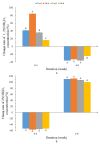Effects of B-Wave Ultraviolet Supplementation Using Light-Emitting Diodes on Caged Laying Hens during the Later Phase of the Laying Cycle
- PMID: 31861728
- PMCID: PMC7022769
- DOI: 10.3390/ani10010015
Effects of B-Wave Ultraviolet Supplementation Using Light-Emitting Diodes on Caged Laying Hens during the Later Phase of the Laying Cycle
Abstract
Caged laying hens are prone to calcium deficiencies, resulting in osteoporosis and egg quality deterioration during the later phase of the laying cycle. Fluorescent light and light-emitting diodes (LEDs), which are widely used in poultry houses now, are both deficient in ultraviolet (UV) light, the lack of which is detrimental to chickens' welfare and health. This study was conducted to investigate the effects of UVB light supplementation using LEDs on the bone traits, blood parameters, laying performance, and egg quality for caged laying hens at 68-75 weeks. In total, 120 Jingfen laying hens were randomly assigned to four different groups, with three replicates in each group (10 hens in each cage as a replicate). UVB-LED lamps installed under the feed troughs were used to provide UVB light (296-316 nm) for the birds in the three treatment groups (1 h, 2 h, and 3 h UVB supplementation per day, respectively), while the control group was not exposed to UVB-LED light. Bone traits, egg quality, and amounts of calcium (Ca), phosphorus (P), 25-hydroxyvitamin D3 (25(OH)D3), 1,25-dihydroxyvitamin D3 (1,25(OH)2D3), and 7-dehydrocholesterol (7-DHC) in both the serum and egg yolks were tested during the experiment. The results demonstrated that UVB-LED exposure significantly increased the bone mineral density (BMD), egg production, and yolk 1,25(OH)2D3 concentrations (p < 0.05), and reduced the content of serum 7-DHC (p < 0.05), especially in the 2 h/day group; however, it did not improve egg quality, vitamin D metabolites, or photoproducts in the serum and yolk 25(OH)2D3 concentrations (p > 0.05). This study concluded that UVB supplementation using LEDs had a positive effect on caged laying hens during the later phase of the laying cycle.
Keywords: bone quality; egg quality; light supplementation; poultry; ultraviolet light-emitting diode.
Conflict of interest statement
The authors declare no conflicts of interest.
Figures





Similar articles
-
Minimal effects of ultraviolet light supplementation on egg production, egg and bone quality, and health during early lay of laying hens.PeerJ. 2023 Mar 15;11:e14997. doi: 10.7717/peerj.14997. eCollection 2023. PeerJ. 2023. PMID: 36942000 Free PMC article.
-
Effect of fluorescent vs. poultry-specific light-emitting diode lights on production performance and egg quality of W-36 laying hens.Poult Sci. 2018 Mar 1;97(3):834-844. doi: 10.3382/ps/pex371. Poult Sci. 2018. PMID: 29272505
-
Effect of short-term UVB exposure on vitamin D concentration of eggs and vitamin D status of laying hens.J Agric Food Chem. 2012 Jan 25;60(3):799-804. doi: 10.1021/jf204273n. Epub 2012 Jan 11. J Agric Food Chem. 2012. PMID: 22185347
-
Non-linear increase of vitamin D content in eggs from chicks treated with increasing exposure times of ultraviolet light.J Steroid Biochem Mol Biol. 2015 Apr;148:7-13. doi: 10.1016/j.jsbmb.2014.10.015. Epub 2014 Oct 27. J Steroid Biochem Mol Biol. 2015. PMID: 25445915 Review.
-
Welfare implications of avian osteoporosis.Poult Sci. 2004 Feb;83(2):184-92. doi: 10.1093/ps/83.2.184. Poult Sci. 2004. PMID: 14979568 Review.
Cited by
-
Minimal effects of ultraviolet light supplementation on egg production, egg and bone quality, and health during early lay of laying hens.PeerJ. 2023 Mar 15;11:e14997. doi: 10.7717/peerj.14997. eCollection 2023. PeerJ. 2023. PMID: 36942000 Free PMC article.
-
Impact of light spectrum electromagnetic radiation variations on performance and hormonal profiles in laying hens.Sci Rep. 2024 Dec 4;14(1):30250. doi: 10.1038/s41598-024-81480-1. Sci Rep. 2024. PMID: 39633043 Free PMC article.
-
Preference testing for UV light spectrum and intensity in laying hens.Poult Sci. 2021 Jun;100(6):101063. doi: 10.1016/j.psj.2021.101063. Epub 2021 Feb 19. Poult Sci. 2021. PMID: 33872863 Free PMC article.
-
Managing Free-Range Laying Hens-Part A: Frequent and Non-Frequent Range Users Differ in Laying Performance but Not Egg Quality.Animals (Basel). 2020 Jun 6;10(6):991. doi: 10.3390/ani10060991. Animals (Basel). 2020. PMID: 32517207 Free PMC article.
References
-
- Zhang L.X., Shi Z.X., Wang X.Y., Geng A.L., Li B.M. Effects of ultraviolet radiation on skeleton development of broiler chickens. Agric. Sci. China. 2006;5:313–317. doi: 10.1016/S1671-2927(06)60055-2. - DOI
-
- Mitchell R., Edwards H., Mcdaniel G. The effects of ultraviolet light and cholecalciferol and its metabolites on the development of leg abnormalities in chickens genetically selected for a high and low incidence of tibial dyschondroplasia. Poult. Sci. 1997;76:346–354. doi: 10.1093/ps/76.2.346. - DOI - PubMed
Grants and funding
LinkOut - more resources
Full Text Sources

